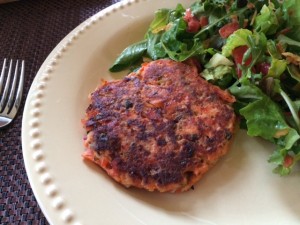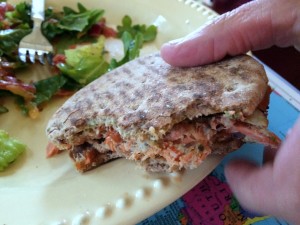The Salmon Burger
What’s for dinner?
When the thermometer soars there’s nothing easier than tossing a whole wild sockeye or a large fillet of king salmon on the grill.
But until my recent visit to the Macaulay Salmon Hatchery in Juneau, Alaska, I didn’t think much about what goes into making sure that salmon is at the market when I want it.
Today we think of more than taste, convenience and cost when deciding what to eat. Availability, environmental consequences and nutrition are considerations.
Even in the vast, gorgeous wilderness of Alaska, salmon eggs and fry are nurtured in 36 hatcheries before being released into the ocean. Macaulay Hatchery releases approximately 120 million juvenile salmon into the ocean every spring. As salmon always attempt to return to their home stream to spawn, the hatchery expects 1% to 10% of released fish return in 2 to 7 years when they have reached adulthood and are ready to spawn.
The work of the hatchery is called “ocean ranching” to ensure the survival of more wild salmon. It is not to be confused with fish farming which was made illegal in Alaska in 1992. (Reference 1).
Alaska has an excellent track record for protecting seafood resources. According to the Alaska Seafood Marketing Institute’s website, “Alaska’s long-term fisheries management success record is unparalleled virtually anywhere in the world…Alaska’s salmon harvests have increased well beyond historical levels with abundant salmon harvests for more than three decades …” (Reference 2 )
The Monterrey Bay Aquarium’s Seafood Watch program helps people select environmentally friendly seafood. Wild Alaska salmon gets a top ranking of “Best Choice” and “Good Alternatives” are any wild salmon from California, Oregon or Washington, wild Coho from British Columbia or any wild salmon from a marine Stewardship Council Certified Fishery.
Consuming a variety of fish is a good idea. Other omega-3–rich fish rated highly for sustainability include wild US or Canadian mackerel, sablefish, Pacific sardines, Albacore tuna, Hawaiian Opah, striped bass, Atlantic herring, bluefish and farmed Arctic Char (Reference 3).
The health benefits of the omega-3 fats in salmon (and other fatty fish), discussed in my blogpost on Copper River salmon have boosted salmon’s popularity and led to booming fish oil sales.
A New York Times article, Fish Oil Claims Not Supported by Research (Reference 4), states that 10% of Americans take fish oil, the third most popular supplement after vitamins and minerals, despite the fact that many experts generally recommend eating fish over taking supplements. When you eat fish you get more than healthy fat, you get high-quality protein, vitamin D and other vitamins and minerals.
The American Heart Association’s recommends that people get their omega-3 fats by eating at least two servings of fish, preferably fatty fish, two times each week. People who eat no fish or have conditions such as high blood triglycerides may benefit from supplements but experts recommend doing so in consultation with a medical provider. (Reference 5). The American Institute for Cancer Research doesn’t recommend fish oil or other supplements for cancer prevention either (Reference 6). This is likely not the end of the story on the health benefits of fish oil – stay tuned as the research continues.
Back to the kitchen where my summertime zeal for wild salmon means there is often a pound or so left over – enough for salmon burgers. Made with fresh ingredients – homemade bread crumbs, herbs from your summer garden, a little onion, lemon and capers – they rise above any frozen or pre-made burger.
Salmon Burgers
Makes 6 burgers.
1 large egg
3 tablespoons prepared mayonnaise or hummus
2 tablespoons finely chopped fresh thyme or other herb
1 tablespoon drained capers
1 tablespoon lemon juice
1 1/2 teaspoons Dijon mustard
1 teaspoon finely grated lemon zest
3/4 teaspoon freshly ground black pepper
3/4 teaspoon fine sea salt
1 pound skinless, cooked salmon filet, bones removed
3/4 cup fresh breadcrumbs, preferably from whole grain bread
1/2 cup thinly sliced chives, green onion or finely chopped red onion
1 to 2 tablespoons olive oil
1. Break egg into large bowl. Whisk to blend. Whisk in mayonnaise, thyme, capers, lemon juice, mustard, zest, pepper and salt. Stir in breadcrumbs and onion. Add salmon and mix until blended, breaking down large flakes of salmon. Form mixture into 6 patties.
2. Heat 1 tablespoon olive oil in large nonstick skillet over medium-low heat. Add patties and cook for 10 to 12 minutes, turning once, until golden brown and cooked through. (Drizzle in additional olive oil as needed.)
3. Serve burgers plain, with lemon wedges or burger-style on buns with condiments of your choice. Makes 6 burgers.
References
1. Macaulay Salmon Hatchery http://dipac.net/New%20VC%20Website/faq.html
2. The Alaska Seafood Marketing Institute http://sustainability.alaskaseafood.org/historical
3. Can Fish Oil Help Keep You Young? Tufts Health & Nutrition Letter. September 2014. Vol. 32. No. 7. P. 7.
4. Fish Oil Claims Not Supported by Research, by Anahad O’Connor, the New York Times, March 30, 2015 http://well.blogs.nytimes.com/2015/03/30/fish-oil-claims-not-supported-by-research/?_r=0
5. Fish and Omega-3 Fatty Acids, The American Heart Association http://www.heart.org/HEARTORG/GettingHealthy/NutritionCenter/HealthyDietGoals/Fish-and-Omega-3-Fatty-Acids_UCM_303248_Article.jsp
6. Fish and Cancer Risk. AICR ScienceNow. Spring, 2015, p.2.
© 2013 Lorelle Del Matto




 About lorelle
About lorelle
[…] I use the rest to make another meal such as Salmon Burgers […]